6.4 Nutrients such as carbon cycle through ecosystems.
On Earth, nutrients cycle through both biotic and abiotic components of an ecosystem–organisms, air, land, and water. They are stored in abiotic or biotic parts of the environment called reservoirs, or sinks, and linger in each for various lengths of time, known as residence times. Organisms acquire nutrients from the reservoir, the chemical cycles through the food chain, and eventually the chemical is returned to the reservoir. For carbon, the atmosphere–where carbon is stored as CO2–is the most important reservoir. (Oceans and soil are also abiotic reservoirs for carbon. Oceans absorb CO2 directly from the atmosphere and soils accumulate it during decomposition.) Plants and other photosynthesizers use carbon molecules from atmospheric CO2 to build sugar, releasing oxygen in the process. Because they “produce” sugar, an organic molecule, from inorganic atmospheric CO2, they are called producers.
This sugar molecule represents stored chemical energy that the producer can use. A consumer, the organism that eats the plant (or that eats the organism that eats the plant), also uses the chemical energy of sugar. This energy is released to the cell via the process of cellular respiration. [infographic 6.7] All organisms—producers and consumers—perform cellular respiration. (For more information on producers, consumers, and the food chain, see Chapter 8.)
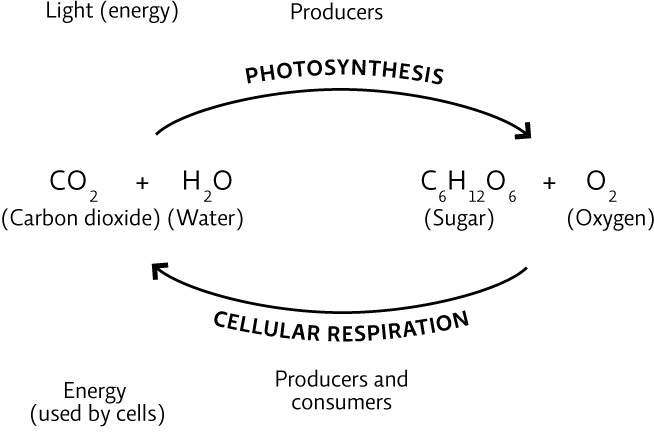
104
From its initial incorporation into living tissue via photosynthesis, to its ultimate return to the atmosphere through respiration or through the burning of carbon-based fuels, carbon cycles in and out of various molecular forms and in and out of living things as it moves through the carbon cycle. [infographic 6.8] Even though a single carbon atom might cycle in a few weeks or years, decades can pass before changes in a Brazilian rainforest impact a farm in Ontario. Inside Biosphere 2, the same cycle took approximately 3 days, which meant that changes in one biome could be felt in another biome much more quickly than on Earth.
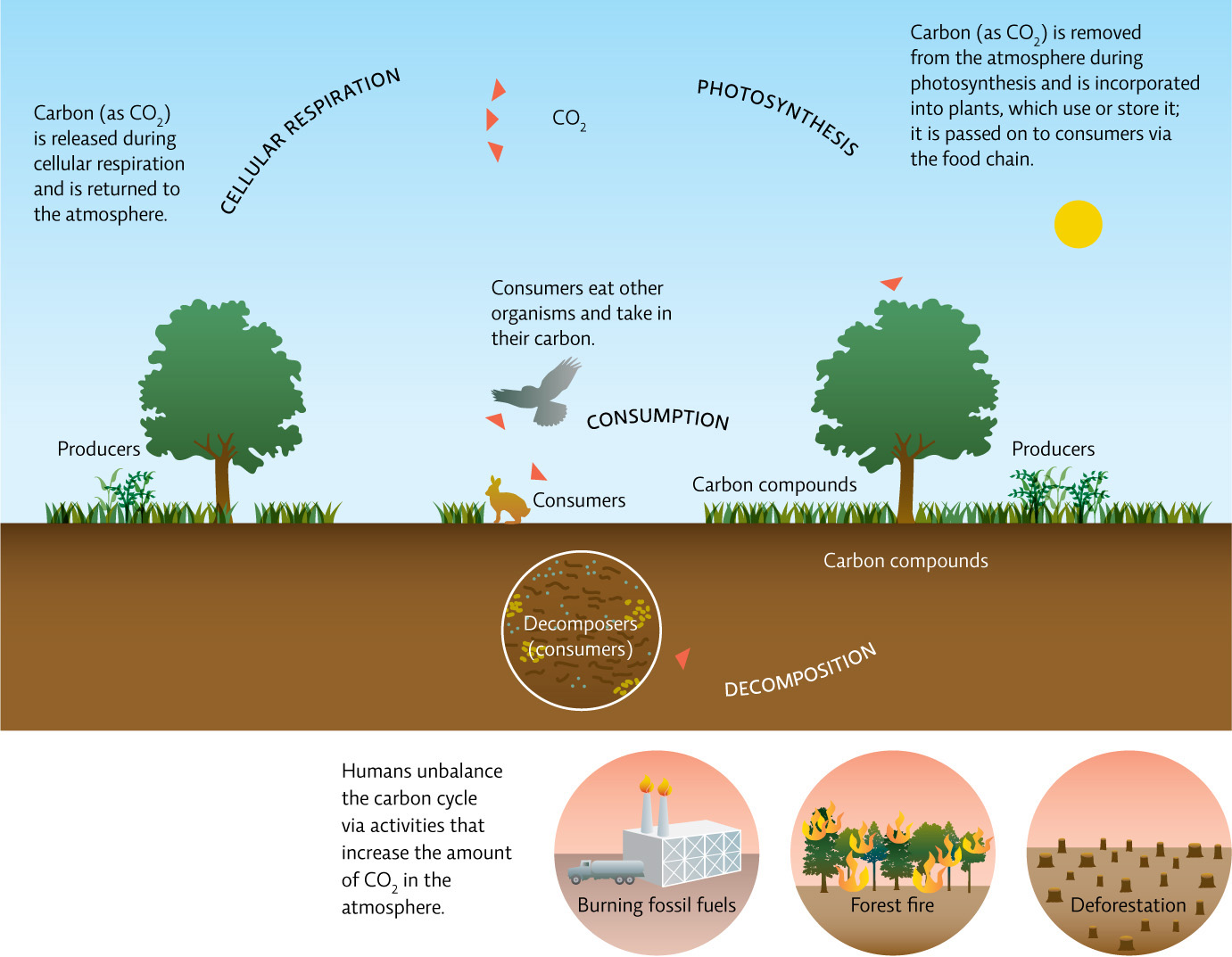
Still, Biosphere 2’s carbon cycle was not that different from Earth’s—carbon moved from living tissue to the atmosphere and back in the same predictable manner. Or at least it should have. As the biospherians’ energy waned, it became clear that something had gone terribly wrong.
It turned out that oxygen levels had fallen steadily—from 21% down to 14%. At such low concentrations, the biospherians were unable to convert the food they consumed into usable energy. “We were just dragging ourselves around the place,” Poynter says. “And we had sleep apnea at night. So we’d wake up gasping for air because our blood chemistry had changed.”
105
In just a few months, more than 6 metric tons of oxygen—enough to keep six people breathing for 6 months—had gone missing. As scientists from Columbia University later discovered, soil microbes were gobbling up all that O2 and converting it into CO2 as they decomposed the organic matter in the soil. [infographic 6.9]
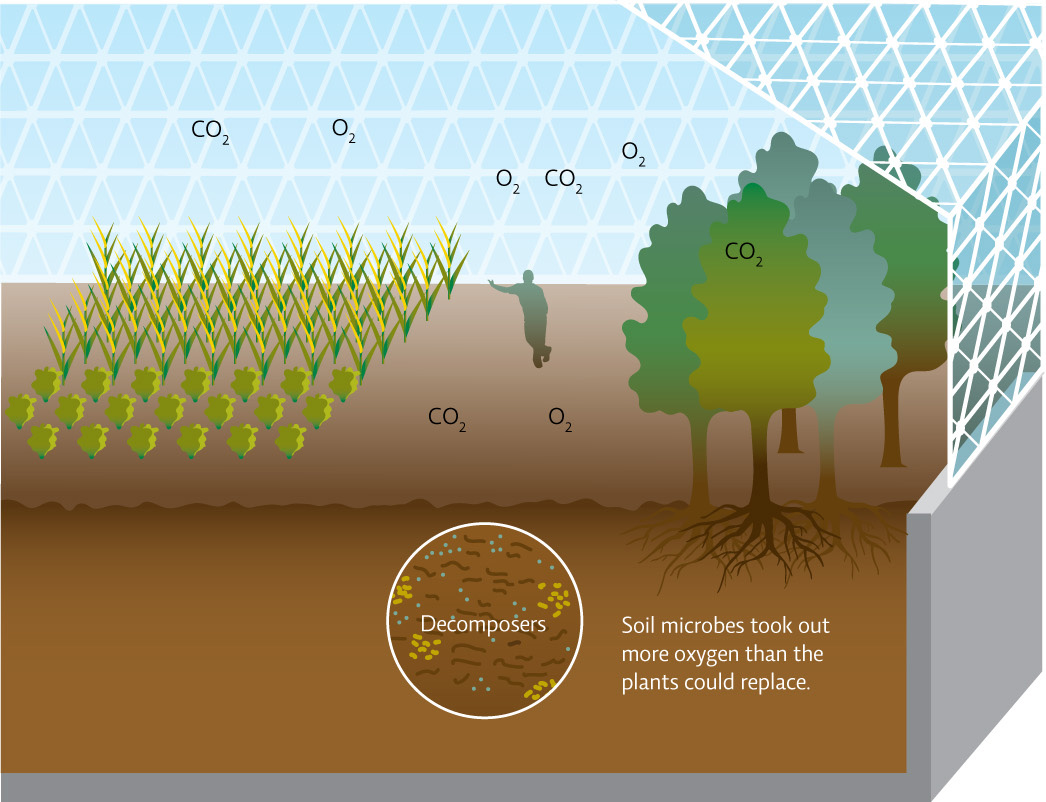
The biospherians responded by filling all unused planting areas with morning glory vines, a pretty and fast-growing (but as it turned out, invasive) species they hoped would maximize the amount of CO2 converted back into O2 by photosynthesis. But even with an abundance of plants and enough CO2, photosynthesis was still limited by the availability of sunlight; not even morning glories could keep up with the soil microbes in their warm, well-watered, highly organic soil.
Biosphere 2 is not alone with regard to a disrupted carbon cycle. Human activity has greatly altered carbon amounts in Earth’s atmosphere. Many of our actions (such as burning fossil fuels) increase the amount of carbon normally released into the atmosphere or degrade natural ecosystems so that less carbon is removed from the atmosphere (as in the case of deforestation). Just like with Biosphere 2, this extra atmospheric carbon causes problems such as global climate change, acidification of oceans, and alterations of communities worldwide.
Adding to the confusion, concrete used to build parts of Biosphere 2 was absorbing some of the CO2 and converting it into calcium carbonate, trapping some of the carbon and oxygen in this unexpected sink.
Besides carbon, other chemicals essential for life, such as nitrogen and phosphorus, cycle through ecosystems. Nitrogen, the most abundant element in Earth’s atmosphere, is needed to make proteins and nucleic acids, but plants cannot utilize nitrogen in its atmospheric form (N2). All plant life, and ultimately all animal life too, depends on microbes (bacteria) to convert atmospheric nitrogen into usable forms as part of the nitrogen cycle.
106
In a process called nitrogen fixation, atmospheric nitrogen (N2) is converted by bacteria into ammonia (NH3) which plants take up through their roots; consumers take in nitrogen via their diet. A small amount of N2 is fixed by lightning, producing nitrate (NO3). In other steps of the nitrogen cycle (decomposition, nitrification, and denitrification) various types of bacteria feed on nitrogen compounds in organic matter or the soil, eventually returning it as N2 to the atmosphere. [infographic 6.10] The nitrous oxide (N2O), or laughing gas, that gave the biospherians trouble is a by-product of denitrification that normally exists in trace amounts in Earth’s atmosphere (it is also becoming a dangerous greenhouse gas, as it is produced in ever-higher concentrations by some human activities).
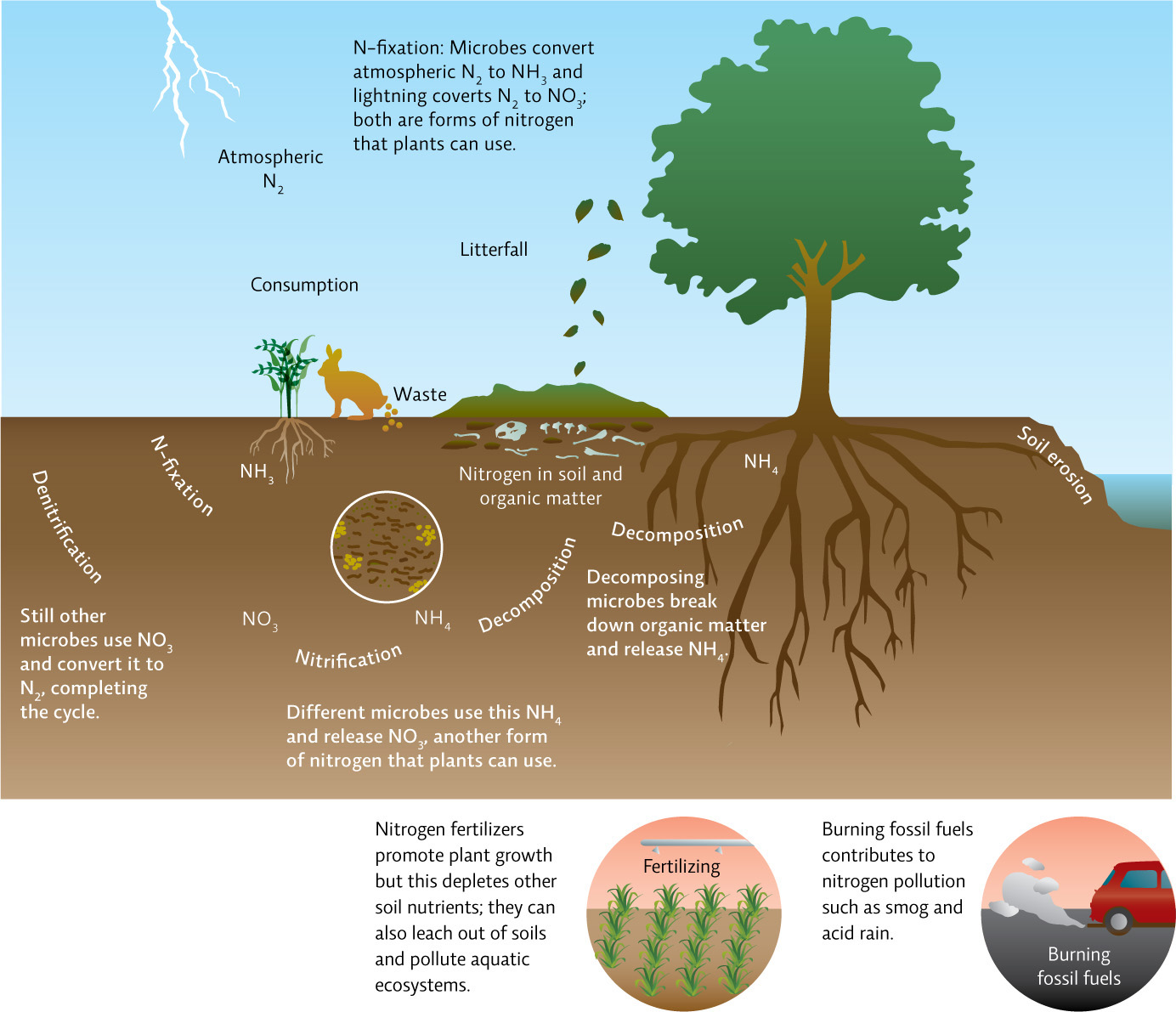
Unlike nitrogen and carbon, phosphorus—which is needed to make DNA and RNA—is found only in solid or liquid form on Earth, so the phosphorus cycle does not move through the atmosphere, but passes from inorganic to organic form through a series of interactions with water and organisms. [infographic 6.11]
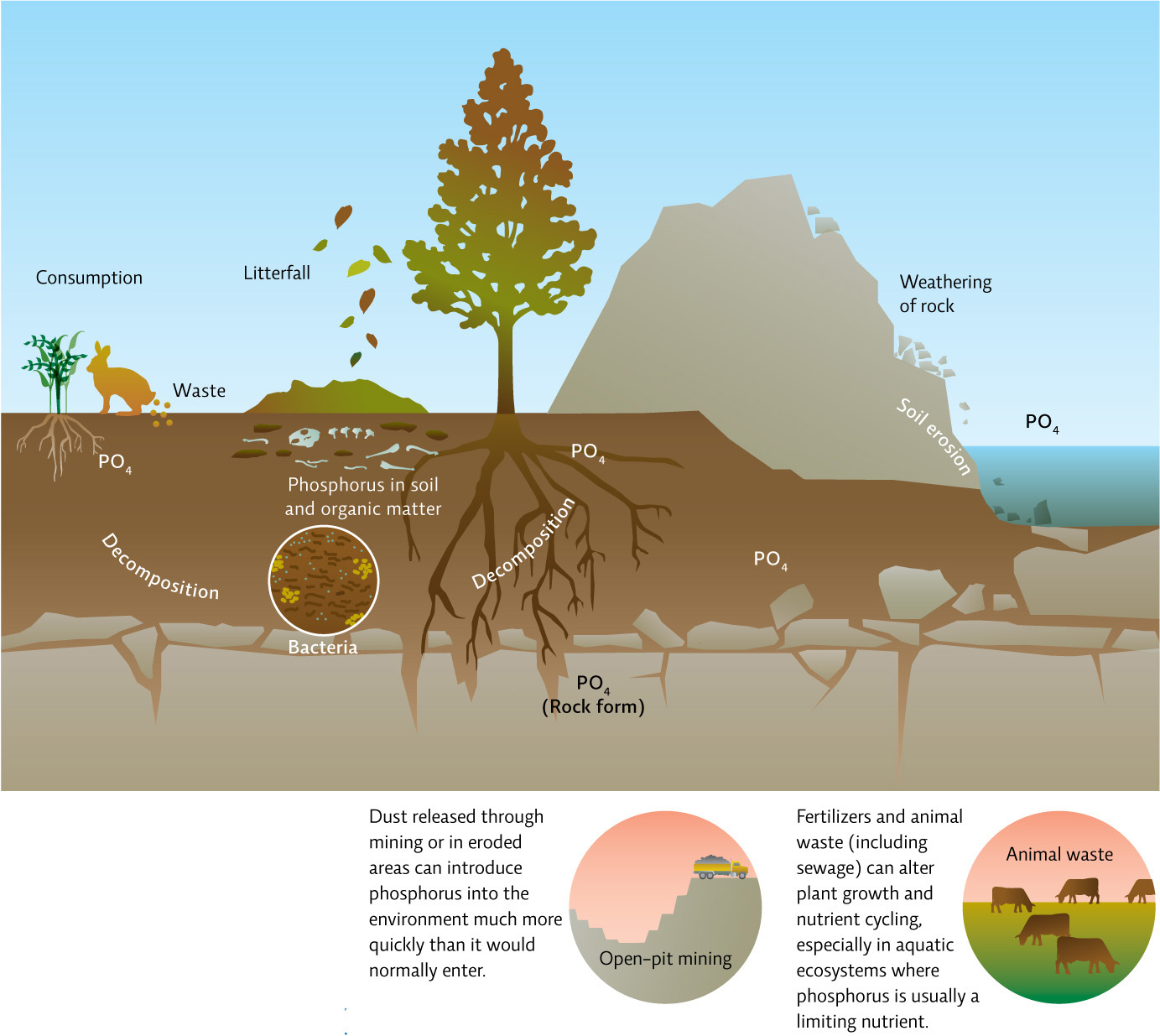
In Biosphere 2, the nitrogen and phosphorus cycles were disrupted. Thanks to an overabundance of soil microbes, nitrous oxide reached levels high enough to interfere with the metabolism of vitamin B12, which is essential to the brain and nervous system.
107
Phosphorus got trapped in the water system, polluting aquatic habitats. The underwater and terrestrial plants of Biosphere 2 were dying off too quickly to complete this cycle. Biospherians removed excess nutrients from their water supply by passing the water over algal mats that would absorb the nutrients and could then be harvested, dried, and stored.
As food reserves dwindled, the eight biospherians split into two factions. One group felt that scientific research was the top priority, and wanted to import food so that they would have enough energy to continue with their experiments. The other group felt that maintaining a truly closed system—one where no biomass was allowed to enter or leave—was the project’s most important goal; proving that humans could survive exclusively on what the dome provided would be essential to one day colonizing the Moon or Mars. To them, importing food would amount to a mission failure. “It was a heartbreaking split,” Poynter says. “Just 6 months into the mission, and two people on the other side of the divide had been my closest friends going in.” Eventually, Poynter snuck food in. That wasn’t the only breech. To solve the various nutrient cycle conundrums, the project’s engineers had installed a CO2 scrubber, and pumped in 17 000 cubic metres of oxygen.
108

Biosphere officials hid these actions from all but a few key people. When one reporter finally broke the story, the public was outraged. Spectators of every ilk—seasoned scientists, skeptical reporters, and casual observers alike—became convinced that other data was also being fudged. “Secrets are like kryptonite to the scientific process,” says Griffin. “Once you find out something has been deliberately overhyped or downplayed, or just plain lied about, all the data from that research becomes suspect. And data that can’t be trusted has no scientific value.”
Three years after the first mission was completed, the editors of the respected journal Science deemed the entire project a failure. “Isolating small pieces of large biomes and juxtaposing them in an artificial enclosure changed their functioning and interactions, rather than creating a small working earth as originally intended,” they wrote. For the $200 million dome to survive as a scientific enterprise, they concluded, it would need dramatic retooling.